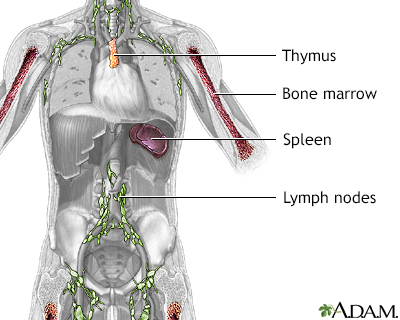Pregnancy SmartSiteTM
Cancer chemotherapy; Cancer drug therapy; Cytotoxic chemotherapy DefinitionThe term chemotherapy is used to describe cancer-killing drugs. Chemotherapy may be used to:
InformationHOW CHEMOTHERAPY IS GIVEN Depending on the type of cancer and where it is found, chemotherapy medicines may be given different ways, including:
When chemotherapy is given over a longer period, a thin catheter can be placed into a large vein near the heart. This is called a central line. The catheter is placed during a minor surgery. There are many types of catheters, including:
A central line can stay in the body over a long period of time. It will need to be flushed on a periodic basis to prevent blood clots from forming inside the central line. Different chemotherapy medicines may be given at the same time or after each other. Radiation therapy may be received before, after, or during chemotherapy. Chemotherapy is most often given in cycles. These cycles may last 1 day, several days, or a few weeks or more. There will usually be a rest period when no chemotherapy is given between each cycle. A rest period may last for days, weeks, or months. This allows the body and blood counts to recover before the next dose. Often, chemotherapy is given at a special clinic or at the hospital. DIFFERENT TYPES OF CHEMOTHERAPY The different types of chemotherapy include:
SIDE EFFECTS OF CHEMOTHERAPY Because these medicines travel through the blood to the entire body, chemotherapy is described as a bodywide treatment. As a result, chemotherapy may damage or kill some normal cells. These include bone marrow cells, hair follicles, and cells in the lining of the mouth and the digestive tract. When this damage occurs, there can be side effects. Some people who receive chemotherapy:
Side effects of chemotherapy depend on many things, including the type of cancer and which drugs are being used. Each person reacts differently to these drugs. Some newer chemotherapy drugs that better target cancer cells may cause fewer or different side effects. Your health care provider will explain what you can do at home to prevent or treat side effects. These measures include:
You will need to have follow-up visits with your provider during and after chemotherapy. Blood tests and imaging tests, such as x-rays, MRI, CT, or PET scans will be done to:
ReferencesCollins JM. Cancer pharmacology. In: Niederhuber JE, Armitage JO, Kastan MB, Doroshow JH, Tepper JE, eds. Abeloff's Clinical Oncology. 6th ed. Philadelphia, PA: Elsevier; 2020:chap 25. Doroshow JH. Approach to the patient with cancer. In: Goldman L, Cooney K, eds. Goldman-Cecil Medicine. 27th ed. Philadelphia, PA: Elsevier; 2024:chap 164. National Cancer Institute website. Chemotherapy to treat cancer. www.cancer.gov/about-cancer/treatment/types/chemotherapy. Updated August 23, 2022. Accessed June 18, 2024. | |
| |
Review Date: 6/17/2024 Reviewed By: Todd Gersten, MD, Hematology/Oncology, Florida Cancer Specialists & Research Institute, Wellington, FL. Review provided by VeriMed Healthcare Network. Also reviewed by David C. Dugdale, MD, Medical Director, Brenda Conaway, Editorial Director, and the A.D.A.M. Editorial team. The information provided herein should not be used during any medical emergency or for the diagnosis or treatment of any medical condition. A licensed medical professional should be consulted for diagnosis and treatment of any and all medical conditions. Links to other sites are provided for information only -- they do not constitute endorsements of those other sites. No warranty of any kind, either expressed or implied, is made as to the accuracy, reliability, timeliness, or correctness of any translations made by a third-party service of the information provided herein into any other language. © 1997- A.D.A.M., a business unit of Ebix, Inc. Any duplication or distribution of the information contained herein is strictly prohibited. | |

 Immune system stru...
Immune system stru...
